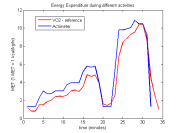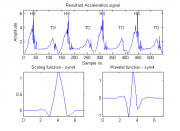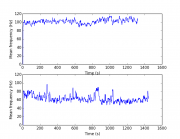HMC2
Human Motion, Categorization and Characterization
| HMC2 | |
| Project start: | |
|---|---|
| 1 January 2012 | |
| Project end: | |
| 31 December 2015 | |
| More info (PDF): | |
| Contact: | |
| Nicholas Wickström | |
| Application Area: | |
| Health Technology | |
Involved internal personnel
| |
| |
Involved external personnel
| |
Involved partners
| |
Abstract
The objective is to design wearable instruments/devices that can characterize and classify human motion. The devices shall be small and “non-intrusive”, similar to a step counter. We are looking at two sensor modalities: inertial sensors (e.g. accelerometers and gyros) and electrical sensors for detecting, e.g., electromyography (EMG) signals.
Background and Motivation
Moderate physical activity can improve health substantially over an individual’s lifetime. Even physically active people can improve their health status by increasing their activity. Physical activity helps to control diseases; adopting healthy behaviors help in decreasing and controlling the effects of diseases like, e.g., diabetes, heart disease, depressions and dementia. There are two important aspects in the problem of increasing the level of physical activity for an individual:
- One is the matter of having a portable method/device for measuring an individual’s level of physical activity.
- The other is the ability to motivate the individual by providing suitable feedback on his/her level of activity.
It is important to develop simple and wearable devices that can measure the daily physical activity of an individual. Such devices can either be used both to monitor physical activity, e.g. in a treatment scenario or to gauge the levels of physical activity in a cohort, or to motivate physical activity. A simple example of such a device is the step counter, though it provides a very coarse measurement and only measures the activity during walking or running. Thus, if a portable device (preferably wearable) would be available that could “ubiquitously” measure different sorts of physical activity and estimate the intensity level, then it would open up new frontiers promoting treatments and pro-active approaches to better health.
For activities such as cycling, muscle fatigue is a major concern as high levels of muscle fatigue can cause serious injuries. It occurs locally and is characterized by the declining ability to perform muscle contractions and force exertions. A person experiencing muscle fatigue will generally feel pain in those muscles. Objective assessment of muscle fatigue would help athletes, trainers and hobby cyclists to assess fitness and prevent muscle injuries. Analysis of electromyographic (EMG) signals can be applied to evaluate local muscle fatigue. Stationary equipment is usually used to record EMG signals.
Approach
- Inertial Sensors: The approach is to use wearable sensors, typically accelerometers, to estimate motion intensities and qualities and estimate energy consumption. The person wearing the sensors can get immediate (or almost immediate) feedback as well as a time log of energy consumption.
- EMG: The approach is to use EMG sensors weaved into a wearable textile belt, which can be comfortably put on a leg. Other modalities than EMG sensors can also be weaved. Some processing can be done in the sensors and for e.g., a smart phone can be used for more advanced analysis. The person wearing the belt can therefore get immediate information on muscle status as well as results of a comprehensive analysis of the data after the training session.
Results so far
Inertial Sensors
A large data collection, involving around 20 subjects, is ongoing. The target is to validate our previously developed algorithm for estimation of energy expenditure for common activities in the low to medium intense activity range. To make the best possible validation, the gold standard for measurement of energy expenditure is used as a reference. Furthermore, several different placement options are selected to measure sensitivity to sensor placement on the body. An example of a pilot measurement is shown in Figure 1, where one subject performed a protocol of different activities. The red curve is measured by the VO2 apparatus (50K+ EUR) whereas the blue curve is estimated by the ActiveMeter (which is developed by members of the project team).
To develop applications for long term analysis of gait in uncontrolled environments, some of the proposed methods in the literature for estimation of the characteristic events (heel strike and toe-off) in gait is not good enough. A new method based on continuous wavelet transform, see Figure 2, in combination with prior expert knowledge was proposed [2]. The method can robustly find the events for "outdoor walking", even when the data is very noisy due to ground conditions and other movement artifacts.
The estimated information could not only prove useful for sports applications, optimization of cadence and similar, but also for healthcare applications such as estimating gait variability over time to assess the risk of falling, especially for the elderly.
EMG
Two subjects participated in the data collection experiment conducted at the facilities of the Sports Academy of University of Gothenburg. Progressively increasing and constant loads were used and EMG signals were recorded from four muscles of both legs, eight channels in total. In addition to EMG signals, readings from accelerometers attached to the legs and chest, as well as measurements of heart rate, oxygen consumption, lactate concentration in blood, cadence and subjective evaluations of fatigue were also taken. Data collection activities have been continued in December 2013 at Halmstad University using the same protocol with the exception that the load was kept constant.
A random forest-based lactate level prediction model was build using data of the first experiment. Each 512 samples long EMG signal segment was characterized by 50 features reflecting signal variability and distribution of signal energy. Table 1 summarizes performance of the model, where the coefficient of determination of the model estimated on unseen data is shown for data collected from different muscles. In Table 1, M stands for muscle, L for leg, COM means combination (data from both legs of two participants are used), RF, VL, SR, and BF denote four different leg muscles, LR, LL, MR and ML stand for left and right leg of subject L and subject M. The study has shown that:
- during dynamic exercise, fatigue does not manifest itself consistently in change of the mean/median frequency of the EMG signals (see Fig. 3)
- however, information is present in signal variability and distribution of signal energy (relatively high prediction accuracy shown in Table 1)
| |||||
Markus Schafflinger (2012). Quality Assessment of Bicycle Training. Master Thesis, Halmstad University.



